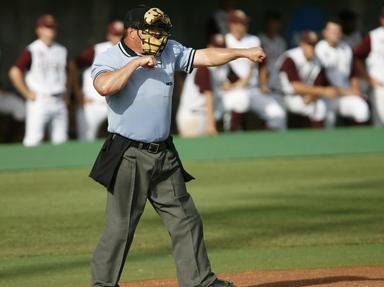Quiz Answer Key and Fun Facts
1. As most baseball fans know, left-handed hitters tend to do better against right-handed pitchers than they do against fellow lefties. Likewise, southpaw pitchers are at something of a disadvantage against right-handed hitters relative to their performance against left-handers. Over the years, many managers have tried to exploit this differential with a strategy called "platooning", playing as many left-handed hitters against right-handed pitchers as possible and vice versa.
One of the greatest exponents of this practice was Casey Stengel. In 1954, Casey's Yankees were playing the Detroit Tigers in the Bronx. In the first inning, four of five Yankees reached base, scoring one run and loading the bases. Anticipating Yankees' right-handed hitter Moose Skowron batting sixth, Tiger manager Fred Hutchinson replaced his left-handed starter Al Aber with right-handed Ralph Branca to gain the platoon advantage. How did Casey respond? (Hint: this would have been VERY typical of Casey's managing style while with the Yankees.)
2. Perhaps the most controversial manager of all, Billy Martin was as prone to on-field eccentricity as he was to off-field excess. He once drew his batting lineup out of a hat (and won) and nearly assaulted Reggie Jackson when Mr. October ignored a signal to bunt. In 1983, Martin noticed that future Kansas City Royals Hall of Famer George Brett was in the habit of using an illegal bat. Martin waited until a key hit of Brett's (a ninth-inning go-ahead home run against Martin's Yankees) to point this out, thus changing a dramatic homer into a game-ending out. What, according to Martin and the game's original umpires, made Brett's bat illegal?
3. One of the most influential managers since the 1960s was Baltimore Orioles skipper Earl Weaver, known for his resolute philosophy of the game that he would expound upon in his book, "Weaver on Strategy". Which of these was not one of the tactics he advocated?
4. The winningest manager in baseball history (posting a record won-lost percentage of .615), Joe McCarthy established his reputation as a hard-nosed manager in his first year as a big-league skipper by releasing a future Hall of Fame pitcher for breaking team rules. Later in his career, however, he would bend his dress code because of the refusal of one player to wear a shirt and tie, saying, "If I can't get along with a .400 hitter, that's my problem". Who were these two all-time greats?
5. In 1929, Connie Mack's Philadelphia A's squared off against Joe McCarthy's Chicago Cubs in the World Series. To the shock of most spectators and writers, Mack picked a 35-year-old oft-injured pitcher who had won only seven games that season (with a mere 20 strikeouts) to start the first game. To the wonderment of all, this veteran hurler won the game and set a World Series record (since broken) with 13 strikeouts. Who was Mack's surprise pick?
6. Hugo Bezdek managed the Pittsburgh Pirates from 1917-1919. Though later a College Hall of Fame football coach at Penn State and by all accounts an expert on training and motivating athletes, Bezdek was not exceptionally well-versed in the intricacies of baseball strategy. Rather than try to improvise clever moves against seasoned baseball skippers, Bezdek made it a habit to consult with some of his veterans, many of whom had played for great managers before coming to the Pirates and would become exceptional managers later in their careers. Which of these future managerial greats did not play for Hugo Bezdek?
7. Walter Alston managed the Brooklyn/Los Angeles Dodgers from 1954 to 1976, winning seven pennants and four World Series. In 1974, Alston's last National League championship season, which of these eye-popping strategies did the Dodger skipper employ?
8. Though the 1994 season was marred by a strike that forced the cancellation of the World Series, it did feature one of the best All-Star games in the history of that contest. The lead changed five times, with the National League coming from behind to tie the game in the ninth inning, then go on to win in the tenth. The highlight of the game was the game-tying home run in the ninth inning by Fred "The Crime Dog" McGriff, who had been held back by the National League manager for the duration of the game to be used as a pinch hitter in just such a situation. Who was the NL skipper that made the clever move to save McGriff for this key at-bat?
9. In 1977, Chicago Cubs relief pitcher Bruce Sutter began the season by posting a 0.67 ERA in his first 37 games, recording 21 saves in 67 innings. In 1978, he began almost as impressively, maintaining a sub-1.00 ERA into July. Both years, however, Sutter collapsed in the second half, going on the disabled list in 1977 and posting an ERA over 3.00 in 1978. At the beginning of 1979, his manager announced that, to save wear on Sutter's arm, he would only be used to protect leads, not when the Cubs were tied or behind, thus turning any good Sutter performance into a win for the team and a save for Sutter. This quickly became the standard use of a relief ace. Who was the manager that initiated this groundbreaking strategy?
10. By 1987, relief pitchers had started to acquire some of the glamour enjoyed by starters, but the relief role was still held in disdain by some veteran managers and players. Dennis Eckersley, who had won over 150 games as a starter, was coming off a disappointing campaign and appeared to be headed for retirement. What managerial great convinced him to stay in the game as a relief ace, and consequently win a spot in the Hall of Fame?
Source: Author
stuthehistoryguy
This quiz was reviewed by FunTrivia editor
Nightmare before going online.
Any errors found in FunTrivia content are routinely corrected through our feedback system.


